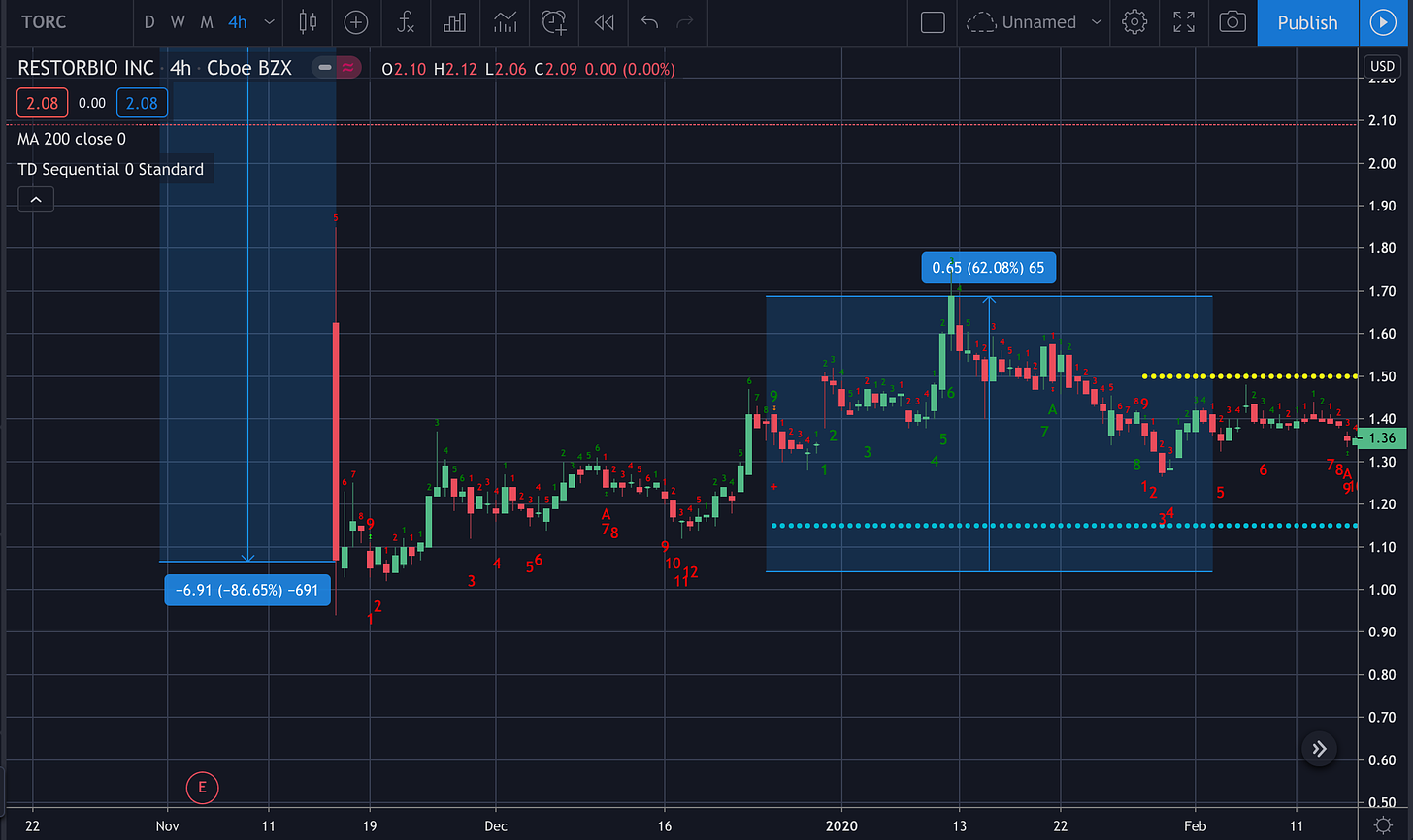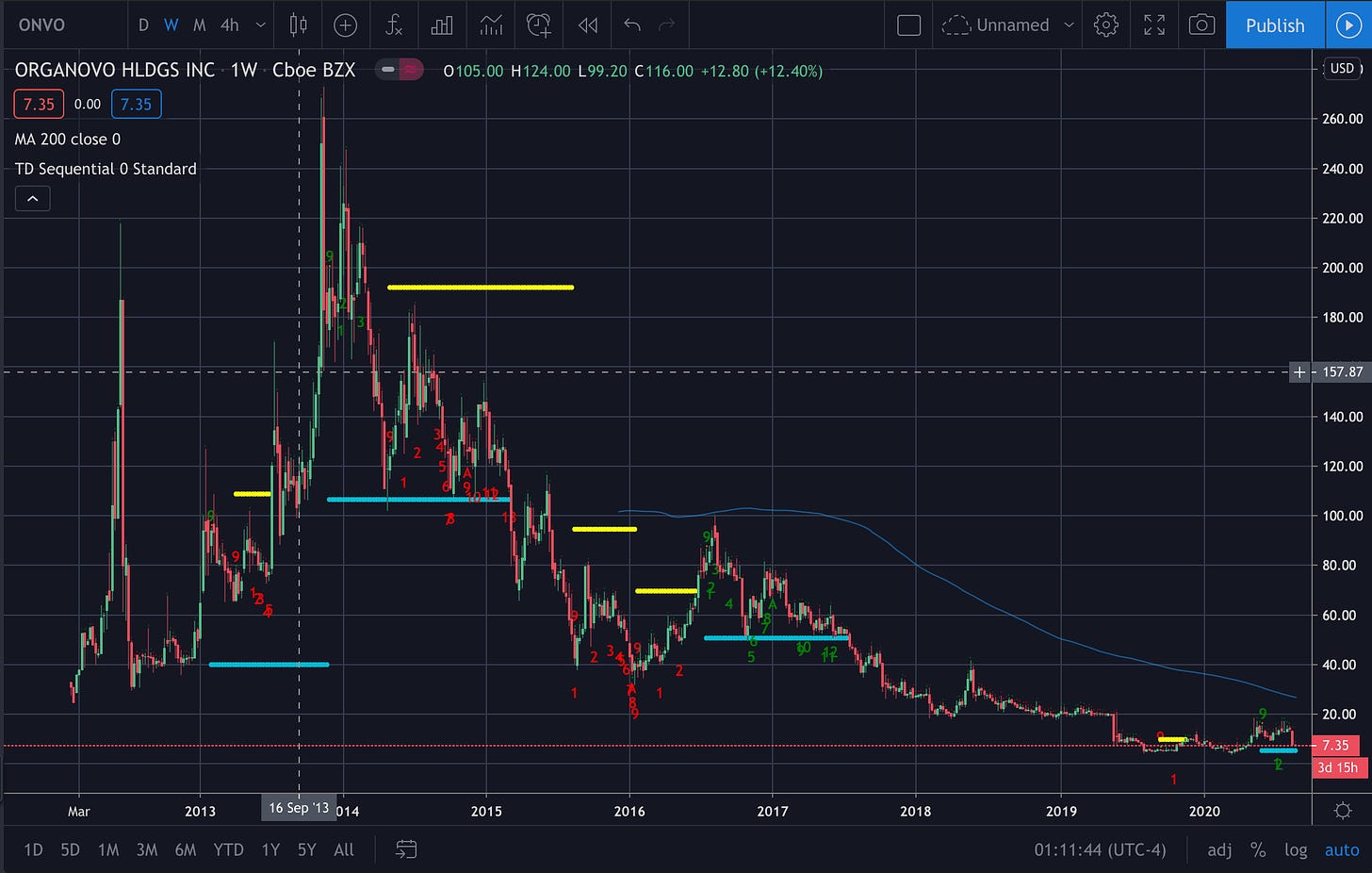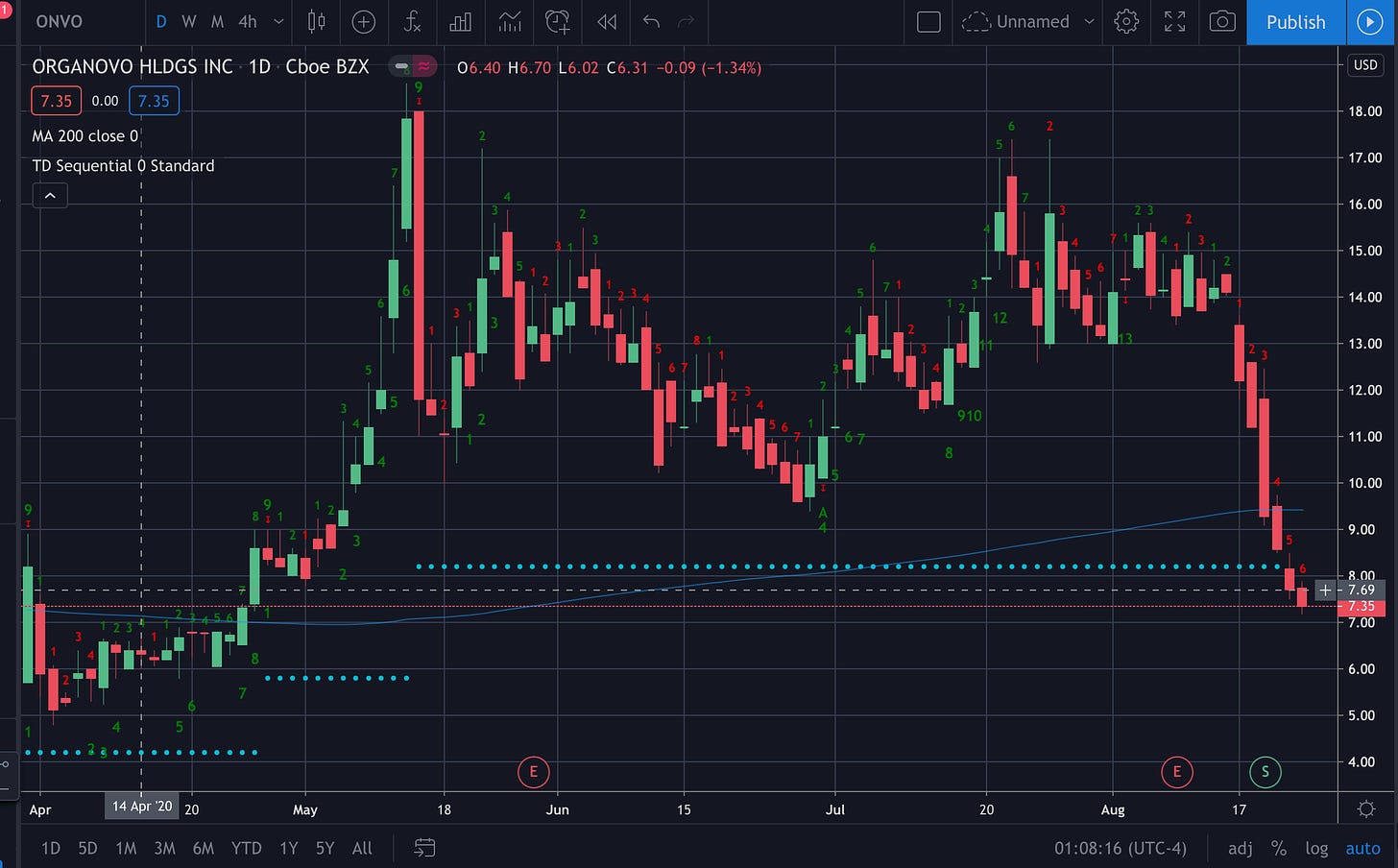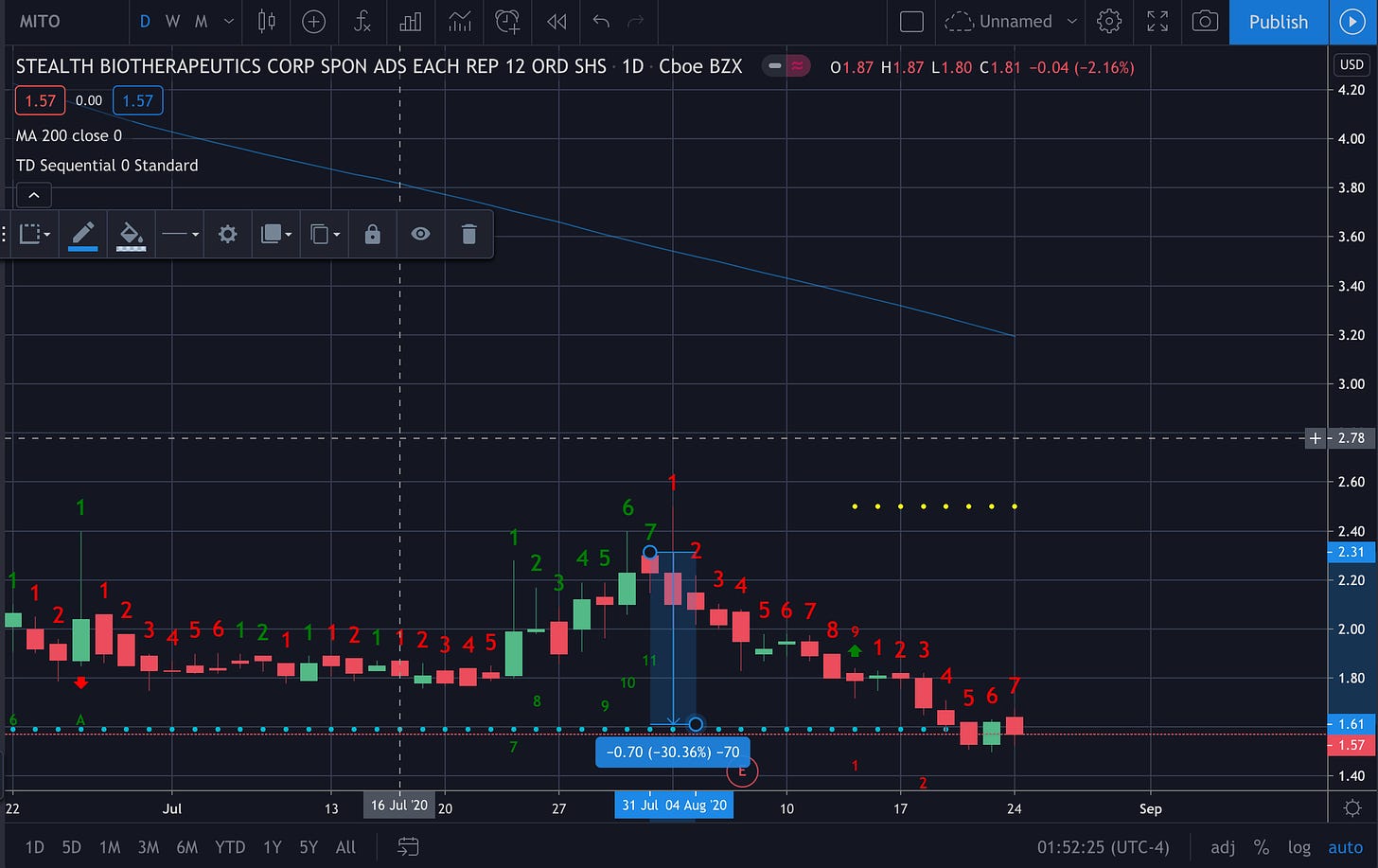#006: Portfolio and UBX Failure Roundup

In this edition of Longevity Marketcap Telemetry:
- Notable last week
- What to look for in the next week(s)
- Why did Unity Biotechnology’s UBX0101 fail? Opinion Round Up.
- “Don’t tell me what you think. Show me what’s in your portfolio.”
- Technical Analysis
*None of this should be taken as financial advice. This information is for education purposes only.
**I have positions in Unity Biotechnology, Mesoblast, and AgeX Therapeutics.
*WARNING: Investing in biotechnology is risky!
Notable last week
Investing
- Unity Biotechnology shares continue to fall — but bounce on Monday. As if the initial 66% drop on the news of their failed Phase II UBX0101 Osteoarthritis trial wasn’t enough, the stock finished down 76% last week. However, Monday the stock bounced up 7%. Is the bottom in? Read on for more analysis.
- Organovo (ONVO) 20-1 reverse split. This California-based 3D tissue bioprinting company announced a 20-1 reverse split on August 17th in order to maintain the minimum $1 bid requirement of the NASDAQ exchange. Reverse splits are usually bad for stock price. Organovo was down -45% for the week. Unfortunate news for a company that was included in Jim Mellon’s longevity stock portfolio and Cathie Wood’s Ark Invest Genomics ETF.
- AgelessRX Rapamycin PEARL Trial. AgelessRX is an online telehealth startup that specializes in prescribing off-label prescription drugs for longevity (metformin, rapamycin). In their sponsor video at EARD 2020 last week they discussed their plans for a Ph. IV trial of rapamycin to target aging. The trial plans to recruit 1000 older patients and measure visceral fat, bone density, and blood panel. Do you take rapamycin for longevity? Let me know in the comments.
- Lifespan.io’s Rejuvenation Roadmap. This webpage tracks all the current longevity therapies and drugs currently in development.
- Added Investors to LongevityList.com. Slowly building up an index of venture capital firms, angel investors, incubators, and parent-companies that invest in longevity. If you know a fund or an angel investor that isn’t on the list email me!
What to look for in the next week(s)?
Investing
- Mesoblast (MESO) expected to release Covid-19 remestemcel-L trial data early September. Ryonocil FDA approval decision for Graft vs Host Disease scheduled September 30th.
Trading
- Has Unity Biotechnology (UBX) stock bottomed? The stock dropped 66% in one day then finished down 76%. On Monday the price was showing signs of life. Is it possible that the carnage is over? See Technical Analysis.
- Organovo (ONVO), Athersys (ATHX), and Stealth Therapeutics (MITO) are all getting close to momentum reversal indicators after dropping fairly large percentages in recent weeks. See Technical Analysis.
Why did UBX0101 Fail? Opinion Roundup.
Here’s a breakdown of some key opinions on the recent UBX0101 Phase II trial failure and senescent cell therapies in general.
José Luis Ricón, Nintil.com
José Luis Ricón writes epics — not the Homeric kind — but rather the longevity science review kind. I highly recommend you check out his Longevity FAQ and Epigenetic Clocks review on his blog. Also his video summary on longevity science.
Here are the main takeaways of why he thinks UBX’s Phase II might have failed:
- Issues with the knee pain self-reporting scoring system? The primary endpoint of the trial measured knee pain using the WOMAC self-reported scoring scale. A Samumed trial also treating osteoarthritis saw no improvement in WOMAC scores but used a different knee pain score (IKDC) as the endpoint, which did see improvement. Given how strong the placebo effect was in UBX0101’s trial perhaps a different scoring system would have shown improvement.
- Need longer observation time? Also comparing the UBX0101 trial to Samumed’s osteoarthritis trial, it looks like a minimum of 12 months would be needed to see an improvement in knee pain. Unity’s data was only 12 weeks.
- Lack of repeat dosage? In the UBX0101 mouse studies an effect was only seen after 5 repeat doses. The UBX0101 Phase II trial was single dose.
- Mouse model OA different from aging? Senescent cells were induced in the mouse model through acute injury. And while UBX0101 was able to clear senescent cells in vitro it might be the case that injury-induced senescent cells are somehow different from age-induced senescent cells.
Like others in this roundup Ricón believes that this one failed trial is not the nail in the coffin for senolytics:
“I think senolytics remain a valid and interesting therapeutic avenue, and the results of this test don’t change that at all.”
Reason, @ Fight Aging! & Repair Biotechnologies
Reason is the author of the Fight Aging! blog and also the co-founder of Repair Biotechnologies. Here’s his speculation as to why UBX0101 failed:
- Mice studies don’t translate for this particular senolytic? Work done by the Mayo Clinic suggests that the senolytics dasatinib and quercetin have translatable benefits for humans as in mice. But perhaps this specific small molecule (UBX0101) just doesn’t translate in humans. It wouldn’t be the first time this has happened.
- UBX0101 single dosage not ideal? Reason believes that Unity’s choice of single dose versus repeat dose injection could have been the downfall. Single dose is simpler and perhaps was chosen for safety reasons (UBX0101 is a repurposed chemotherapeutic drug). But senescent cell factors from secreted from other parts of the body might not be sufficiently dealt with by a localized injection for some people. Reason thinks an oral drug might be a better approach.
- Bad target? UBX0101 inhibits the interaction between p53 / MDM . It is possible that this merely alters the activity of senescent cells in vivo instead of actually removing the senescent cells.
Reason is still very optimistic on senolytics in general:
“Overall, the animal data, and other human data, for the use of senolytics to reverse age-related pathology is compelling. Very compelling. It is unfortunate that the first attempt at bringing an approach to the clinic failed, but numerous other groups are out there working on the problem, and most of them have what look to be better approaches to the challenge.”
Aubrey de Grey, SENS Research Foundation
Highlights from his EARD 2020 Keynote talk. Video isn’t posted publicly yet.
- Senescent cell aging hypothesis still intact. Clinical trials are still just experiments — they just cost a lot more. Sometimes an experiment just will not work. UBX0101 was one such failed experiment. It also did not measure senescent cell removal directly — just self-reported pain scores.
- Senolytic trials going forward need more direct measurement of senescent cell removal. Are the drugs actually removing senescent cells? Need to avoid endpoints with large placebo effects.
Video
For those who are too lazy to read anything, I found a great YouTube video by Eleanor Sheekey explaining the background of senescent cells and UBX0101.
“Don’t tell me what you think. Show me your portfolio.”
This is one of Nassim’s Taleb’s aphorisms. Talk is cheap.
Financial market commentators can say whatever they want but it is meaningless without any skin in the game. (How much money did Jim Cramer have in Bear Stearns?)
So what’s in my (liquid) portfolio? Let’s take a look:
- < 70% cash & bonds
- < 15% “normal equities” & broad based index funds
- < 10% gold and gold miners
- < 10% cryptocurrency exposure (BTC, ETH, includes ETF products)
- < 5% REITs
- ~1 – 2 % longevity biotechnology stocks
You might be surprised that longevity biotech is such a low percentage of my portfolio.
No matter how passionate you are about longevity, the reality is we are still very early for publicly-traded longevity biotech markets. There are perhaps only 10 investible pure play longevity stocks — not great for diversification. Remember biotech is a numbers game.
If we use a conservative estimate of a 90% company fail rate we might expect only one company to succeed long term out of the 10 currently investible stocks. This is not much margin from zero. Non-ergodicity is a bitch.
So at the moment I am investing only what I am willing to lose. If it all goes to zero then I will consider it a donation to longevity science.
Increasing my Longevity Biotech Allocation
However, I do not anticipate my longevity stocks allocation to stay at 1 – 2% forever.
As the longevity industry grows and more companies are go public I will increase my allocation. And if any one of the three following mega-longevity companies go public I would instantly double my allocation (at a minimum):
- Juvenescence: A Jim Mellon company that includes a portfolio of 11 companies.
- Life Biosciences: A parent company founded by Harvard geneticist David Sinclair (and backed by WeWork’s Adam Neumann?) They have a number of daughter companies including Senolytx and Jumpstart Fertility.
- Samumed: Raised over $650 million, valued at ~$12 billion. They develop technologies around the Wnt pathway for regenerative medicine. Currently has Ph. III trials.
Why care about longevity investing now?
You might ask why I should bother putting so much time into reading and writing about longevity companies when it only makes up ~1 – 2% of my portfolio. And now when there are so few public companies.
Well there are three reasons:
- My allocation is ~1 -2 % now but it will eventually become a larger percentage of my portfolio.
- There’s a decent chance that I will end up starting my own longevity biotech company in the near future. Researching the space now will give me an idea of what is being worked on and what is neglected.
- Build up awareness and excitement in this space. This will indirectly drive progress forward.
- I want to be knowledgeable about the space before the multitudes of longevity companies eventually become public to investors. (or I decide to get in on investing in startups).
Let me tell you a tragic story about how important it is to be knowledgeable before the bubble hits:
Back in the summer of 2015 I decided it would be fun to invest in Bitcoin. It was $230 at the time. Unfortunately, my investment was small since I was recently a destitute physics Ph.D dropout turned backpacker. But more importantly I didn’t really understand Bitcoin or cryptocurrencies then.
It wasn’t until years later that I scrambled to read up on crypto during the massive 2017 bubble. As my knowledge increased, I became more confident in the space and the investment thesis. And even though I had more income and knowledge to invest by then, the opportunity to buy bitcoin at those “low” prices had passed.
So it goes.
It takes time to learn new stuff. And in exponential technologies, when you start mastering the field can make the biggest difference.
Technical Analysis
Break out them horoscopes. It’s time to see whether or not the planets have aligned for these stocks.
Unity Biotechnology (UBX)
Unity Biotechnology’s stock crashed 76% before making a 7% pop on Monday this week. This is now a very attractive stock for me to trade. I find it is always an added bonus to trade a stock that you wouldn’t mind holding. If your trade doesn’t go as planned you can always just hold the stock instead of getting stopped out.
I was actually watching UBX last week with the 4h chart. For some reason this time scale works well with TD sequential after large discontinuous movements in price. It works well on IPOs too when there is little to no price history (check out RKT, ALXO, VRM on the 4h)
As you can see UBX looks like it could have bottomed perfectly a week after the drop on a TD sequential 9 reversal indicator. It looks very similar to the kind of post-trial-implosion that resTORbio (TORC) faced in 2019. 
In resTORbio’s case, the stock went on to rise 62% over the next two months. Obviously UBX could do something completely different. But things that drop quickly can rally with stunning momentum as well. A short 1 week-to-bottom would not be unheard of in biotech.
It seems likely that Unity has enough cash to get their UBX1325 eye degeneration senolytic to trial. Phase I is scheduled for this year so I believe the stock could be higher around by the time that day draws near. By how much? Who knows.
Organovo (ONVO)
This 3D bioprinting stock announced a 20-1 reverse stock split and dropped 45% on the week. Nothing can go straight down forever so there will be a bounce eventually. If the TD sequential indicator is triggered this week it might be an interesting trade on Friday (or Thursday end of day).
Zooming out to the full historical chart, this stock looks like an absolute train wreck. It was certainly one of Jim Mellon’s worst picks in his recommended Juvenescence stock portfolios. Not sure why ARK Invest likes it so much either (ARKG). 
Athersys (ATHX)
This stem cell therapy stock has taken a major beating in the past week. It’s also down almost 50% from its highs in April. It could bounce off the 200 day moving average within the next day or two, especially now that we are getting close to a reversal indicator on the 4h chart.
Stealth Therapeutics (MITO)
This mitochondrial / neurodegenerative disease therapy stock has seen better days. It still hasn’t really recovered from its 92% drop in December 2019. However as a trade it is getting close to a reversal of momentum with what could be a double TD 9 after a 30% drop. This stock trades pretty thinly though, so beware.
Bonus: Twitter Trolls
I have finally reached a critical milestone in my longevity writing career: My first Twitter troll. I am flattered.
Never trust anyone that uses that many air quotes “ “ in one sentence.




